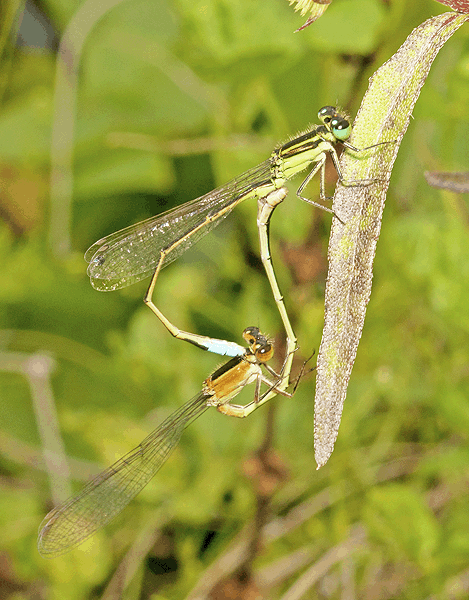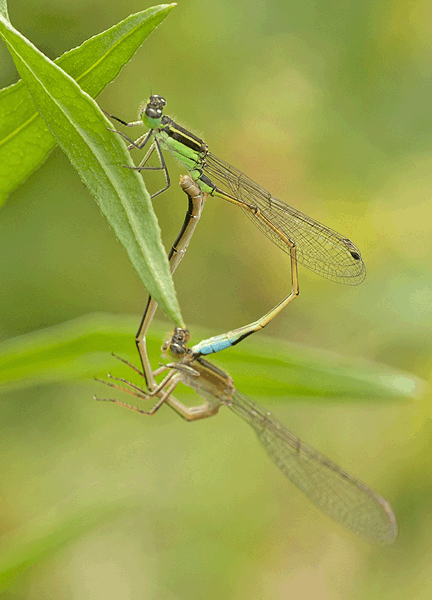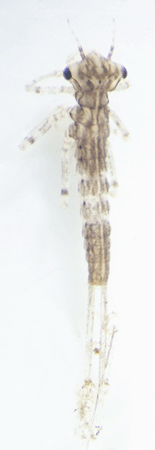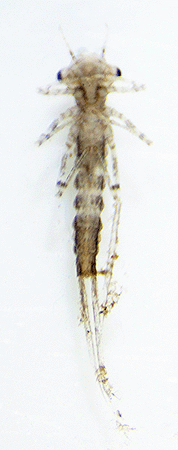Order Odonata (Dragonflies and Damselflies) in the Christopher B. Smith Preserve
Order Odonata Characteristics: "Odonata" means "the toothed-ones" and refers to the fact that members of the order have large jaws and sharp teeth. One hundred-fifty-four identified species of odonates (108 dragonflies and 46 damselflies) breed in Florida. All stages are predaceous and feed on insects and other organisms. Members of the order have chewing mouth parts and incomplete metamorphosis (egg, larval ... aka naiad, and adult stages).
Immature members are aquatic and adults are terrestrial. A larva breathes with gills and has extendible lower lips that lunge out to seize prey. A mature larva crawls out of the water onto a plant stem or rock and undergoes a final molt to become an adult. As an adult, it has four elongate, many-veined, membranous wings, strengthened by a network of wing veins and pleats. Blood is circulated through the wing veins by a special pump-like, small, heart located at the base of the wings. Also, each adult has many-faceted, large, compound eyes; very small and bristle-like antennae; a small and compact thorax; and a long, slender abdomen. One-segmented cerci are used as a clasping organ by males. After mating, the female lays her eggs in or near water. The average maximum adult lifespan is three to four weeks.
Separation of adult members of the order is based primarily on characteristics of the wings; however size, shape, color, and manner of flight are also useful. There are two suborders: Suborder Anisoptera (Dragonflies) and Suborder Zygoptera (Damselflies.)
Suborder Anisoptera: Dragonfly larvae have gills in the form of ridges in the rectum. Dragonfly adults have the bases of their hind wings broader than the front wings. The Suborder name "Anisoptera" means "unequal wing." As shown in this photograph, individuals hold their wings horizontally when at rest. Wing tips have blisters of blood called "stigmata or stigma", Greek for "mark" or "brand." The stigma are believed to add weight to the wings and reduce vibrations, improving flight efficiency. Some dragonflies also have colorful areas on the hindwings called basal wing markings. Males and females may be similarly colored, but the male is frequently brighter. In some cases, males and females have very different coloration. A male can be identified by the three appendages at the end of the abdomen, which it uses to clasp a female. There are seven families of dragonflies in Florida.
Suborder Zygoptera: Damselfly larvae have gills that are three leaf-like structures at the end of the abdomen. Damselfly front and hind wings are similar in shape and narrow at the base. The Suborder name "Zygoptera" means "similar wings." As shown in this photograph, most damselflies hold their wings together above their body when at rest. Their eyes are widely separated which give them good depth perception. Males and females usually differ in color and the males' color is usually more vibrant. Some female damselflies have two or more different color phases, and non-breeding individuals may have an additional color pattern. A male has four appendages at the end of its abdomen, which it uses to clasp a female. There are three families of damselflies in Florida.
Interactions in the Smith Preserve: Dragonflies feed on a variety of small insects, which they catch on the wing in a basket-like arrangement of legs. They can spin 360˚ and reach speeds of 30 mph while pursuing prey. With this great maneuverability and speed, they catch and eat 95% of the small flying insects they attack.
Dragonflies also provide food for parasites and predators. Small, round, red, water mite larvae attach to the underside of the thorax and abdomen of dragonfly larvae. Then, when an adult dragonfly emerges from its last larval molt, the mites attach to the adult. Mites feed on the blood of the host dragonfly. Eventually, mites drop off hosts, return to the water, and develop into free-living predaceous mites. Another problematic parasite of dragonflies is a tiny nocturnal gnat. On warm nights, gnats suck blood from the wings of resting dragonflies. Of its larger predators, birds are of primary importance.
Damselflies are predators of small insects, hosts for parasitic mites, and prey for fish, frogs, lizards, birds, spiders, and dragonflies.
Suborder |
Family |
Species Name |
Common Name |
Anisoptera |
Aeschnidae |
Anax junius |
|
Anisoptera |
Aeschnidae |
Anax longipes |
|
Anisoptera |
Aeschnidae |
Coryphaeschna ingens |
|
Anisoptera |
Libellulidae |
Brachymesia gravida |
|
Anisoptera |
Libellulidae |
Celithemis eponina |
|
Anisoptera |
Libellulidae |
Crocothemis servilla |
|
Anisoptera |
Libellulidae |
Erythemis simplicicollis |
|
Anisoptera |
Libellulidae |
Erythrodiplax berenice |
|
Anisoptera |
Libellulidae |
Erythrodiplax minuscula |
|
Anisoptera |
Libellulidae |
Erythrodiplax umbrata |
|
Anisoptera |
Libellulidae |
Libellula needhami |
|
Anisoptera |
Libellulidae |
Orthemis ferruginea |
|
Anisoptera |
Libellulidae |
Pachydiplax longipennis |
|
Anisoptera |
Libellulidae |
Pantala flavescens |
|
Anisoptera |
Libellulidae |
Perithemis tenera |
|
Anisoptera |
Libellulidae |
Unknown |
|
Anisoptera |
Libellulidae |
Unknown |
|
Zygoptera |
Coenagrionidae |
Argia sedula |
|
Zygoptera |
Coenagrionidae |
Enallagma cardenium |
|
Zygoptera |
Coenagrionidae |
Ischnura hastata |
|
Zygoptera |
Coenagrionidae |
Ischnura posita |
|
Zygoptera |
Coenagrionidae |
Ischnura ramburii |
|
Zygoptera |
Coenagrionidae |
Ischnura sp. |
Suborder Anisoptera ... Dragonflies
Family Aeschnidae ... Darners Anax junius ... Common Green Darner
|
Family Aeschnidae ... Darners Anax longipes ... Comet Darner
|
Family Aeschnidae ... Darners Coryphaeschna ingens ... Regal Darner
|
Family Libellulidae ... Skimmers Brachymesia gravida ... Four - Spotted Pennant
|
Family Libellulidae ... Skimmers Celithemis eponina ... Halloween Pennant
|
Family Libellulidae ... Skimmers Crocothemis servilla ... Scarlet Skimmer
|
Family Libellulidae ... Skimmers Erythemis simplicicollis ... Eastern Pondhawk / Common Pondhawk
|
Family Libellulidae ... Skimmers Erythrodiplax berenice ... Seaside Dragonlet
|
Family Libellulidae ... Skimmers Erythrodiplax minuscula ... Little Blue Dragonlet
|
Family Libellulidae ... Skimmers Erythrodiplax umbrata ... Band-Winged Dragonlet
|
Family Libellulidae ... Skimmers Libellula needhami ... Needham's Skimmer
|
Family Libellulidae ... Skimmers Orthemis ferruginea ... Roseate Skimmer
|
Family Libellulidae ... Skimmers Pachydiplax longipennis ... Blue Dasher Skimmer
|
Family Libellulidae ... Skimmers Pantala flavescens ... Wandering Glider / Globe Skimmer
|
Family Libellulidae ... Skimmers Perithemis tenera ... Eastern Amberwing
|
Family Libellulidae ... Skimmers Unknown Species ... Unknown Common Name
|
Family Libellulidae ... Skimmers Unknown Species ... Unknown Common Name
|
Suborder Zygoptera ... Damselflies
Family Coenagrionidae ... Pond Damsels Argia sedula... Blue-Ringed Dancer
|
Family Coenagrionidae ... Pond Damsels Enallagma cardenium... Purple Bluet
|
Family Coenagrionidae ... Pond Damsels Ischnura hastata ... Citrine Forktail
|
Family Coenagrionidae ... Pond Damsels Ischnura posita ... Fragile Forktail
|
Family Coenagrionidae ... Pond Damsels Ischnura ramburii ... Rambur's Forktail
|
Family Coenagrionidae ... Pond Damsels Ischnura sp... Forktail Naiad
|
© Photographs and text by Susan Leach Snyder (Conservancy of Southwest Florida Volunteer), unless otherwise credited above.

 This darner's breeding range includes Alaska to Panama, Hawaii to Nova Scotia, and Tahiti, Japan, and China. It prefers to live in very slow-moving fresh water, with a lot of aquatic vegetation.
This darner's breeding range includes Alaska to Panama, Hawaii to Nova Scotia, and Tahiti, Japan, and China. It prefers to live in very slow-moving fresh water, with a lot of aquatic vegetation. 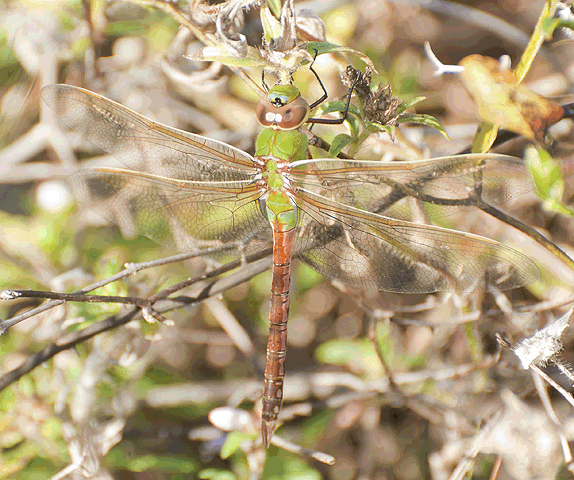 At a quick glance, this male Comet Darner looks very similar to the male Common Green Darner above. However, there are significant differences.
At a quick glance, this male Comet Darner looks very similar to the male Common Green Darner above. However, there are significant differences. 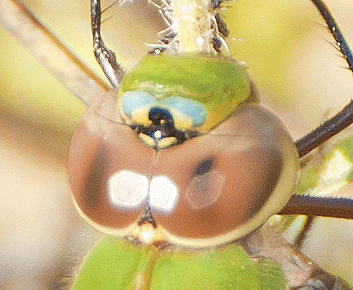 Naiads of the Comet Darner are long and slender. When the naiads are fully developed, they can be distinguished from the Common Green Darner using characteristics of the labium (lower lip).
Naiads of the Comet Darner are long and slender. When the naiads are fully developed, they can be distinguished from the Common Green Darner using characteristics of the labium (lower lip). 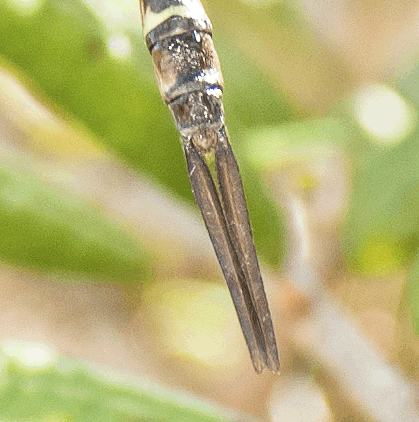
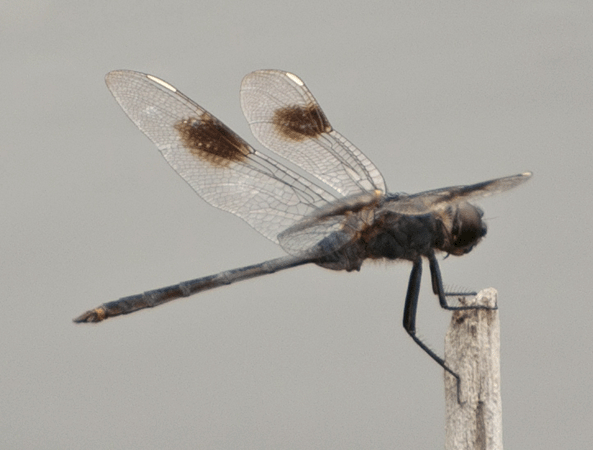 On April 22, 2015, this dragonfly was perched on a stick protruding from the Smith Preserve pond. The pennant landed, left to flit around the area looking for insects to eat, and returned repeatedly to the perch.
On April 22, 2015, this dragonfly was perched on a stick protruding from the Smith Preserve pond. The pennant landed, left to flit around the area looking for insects to eat, and returned repeatedly to the perch. 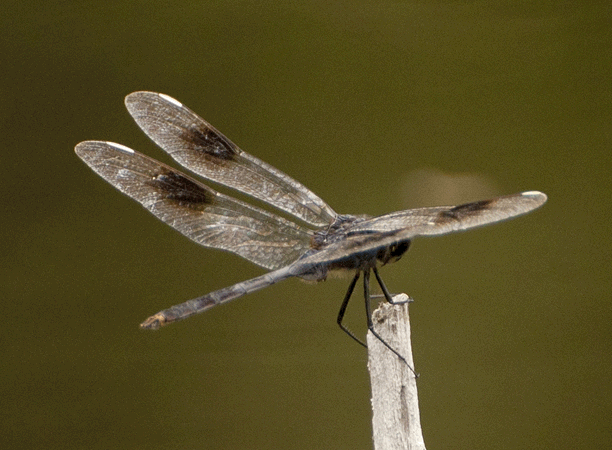
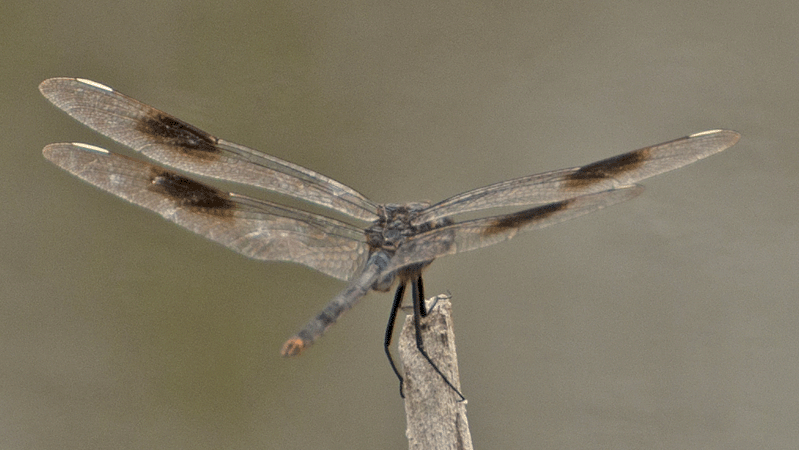
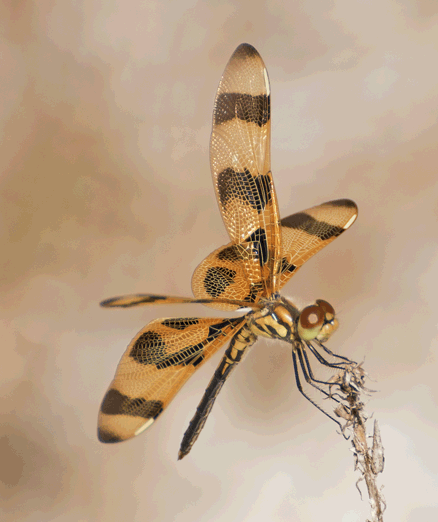
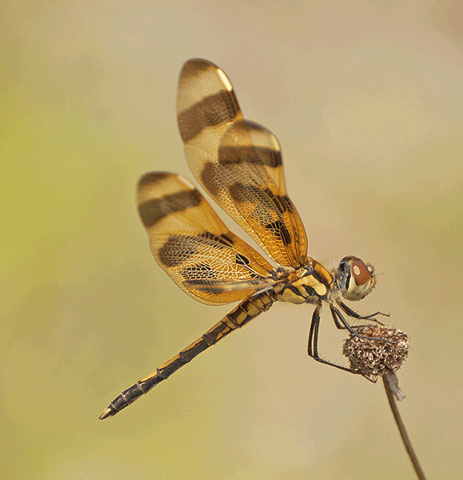
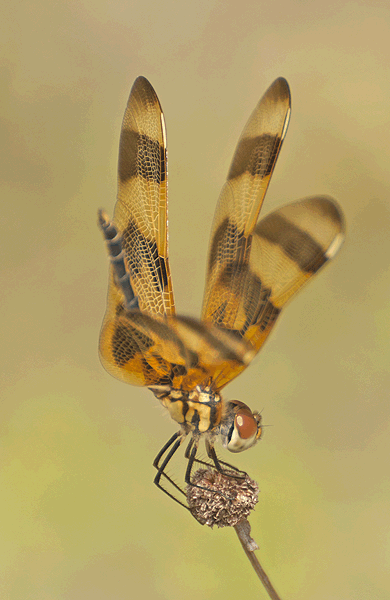

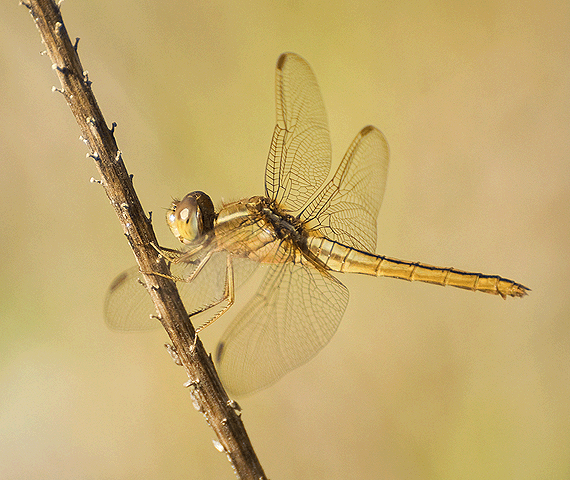
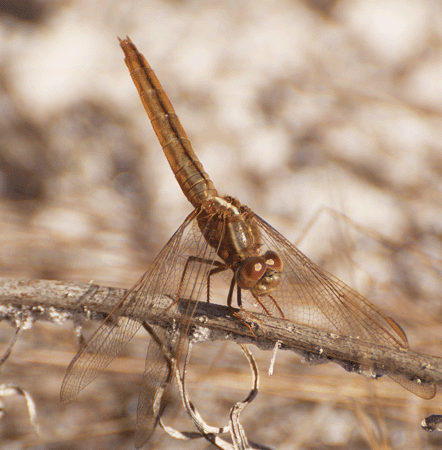 On March 6, 2012, the individuals in the first two photographs were seen in the Smith Preserve and identified by the webmaster.
On March 6, 2012, the individuals in the first two photographs were seen in the Smith Preserve and identified by the webmaster. 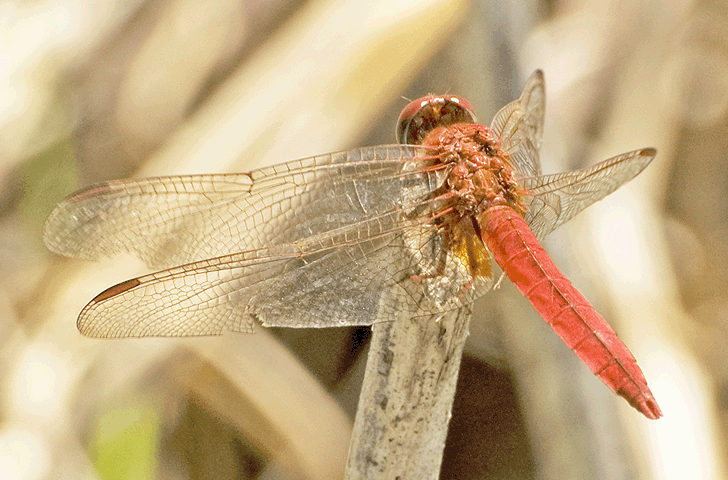
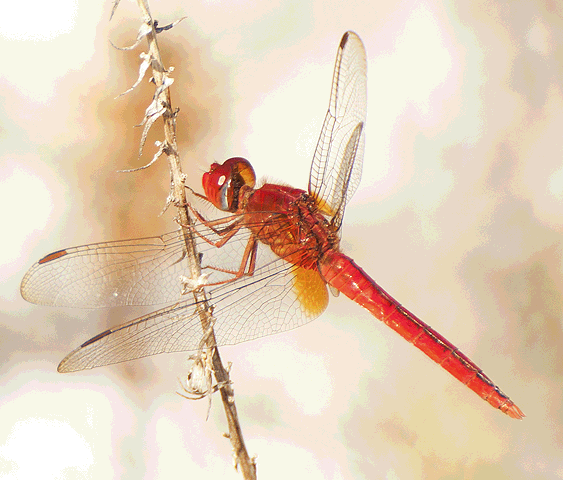
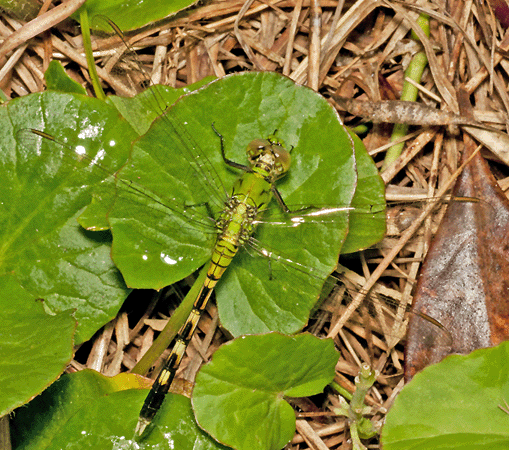 This dragonfly was photographed on March 19, 2012 near the pond in the Smith Preserve.
This dragonfly was photographed on March 19, 2012 near the pond in the Smith Preserve.  On April 20, 2015, this dragonfly was photographed on vegetation adjacent to the pond at the Smith Preserve.
On April 20, 2015, this dragonfly was photographed on vegetation adjacent to the pond at the Smith Preserve. 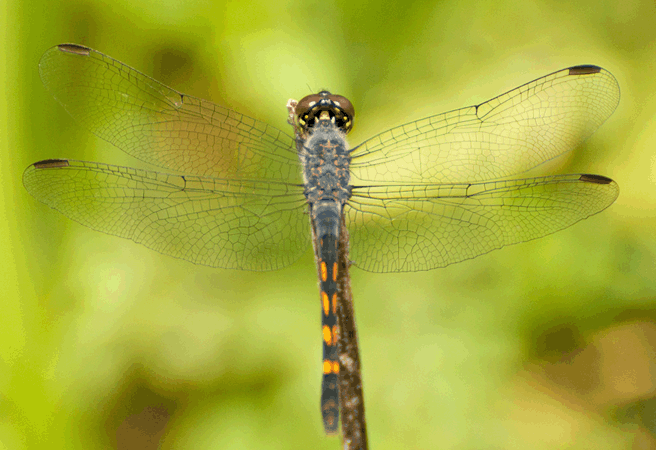 Mature males are very dark; females have much more yellow, and there is also a "male-like form" female. It is believed by the webmaster that this individual is one of those "male-like form" females. Note the bluish thorax and adjacent abdominal segments and the orange spots on the more posterior sections of the abdomen.
Mature males are very dark; females have much more yellow, and there is also a "male-like form" female. It is believed by the webmaster that this individual is one of those "male-like form" females. Note the bluish thorax and adjacent abdominal segments and the orange spots on the more posterior sections of the abdomen. 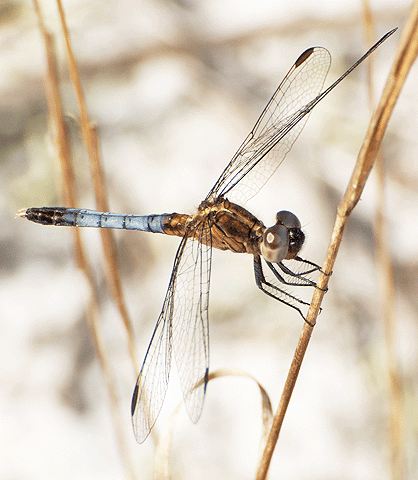 On March 14, 2012, the small dragonfly shown in photographs 1 and 2 was perched on a piece of dried grass beside the Smith Preserve Pond.
On March 14, 2012, the small dragonfly shown in photographs 1 and 2 was perched on a piece of dried grass beside the Smith Preserve Pond. 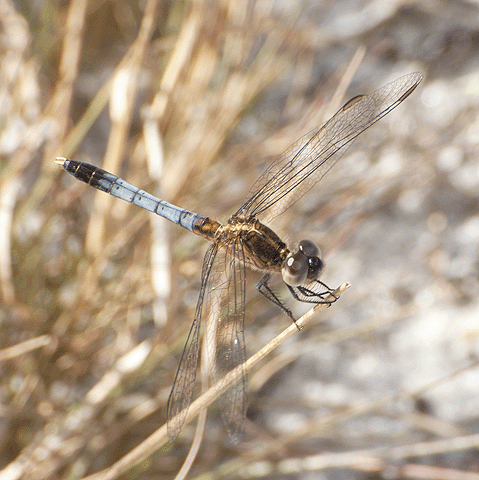 At first glance, this individual looks similar to the male
At first glance, this individual looks similar to the male 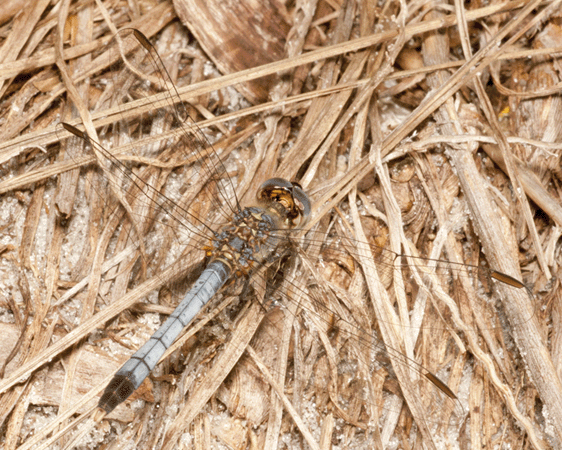
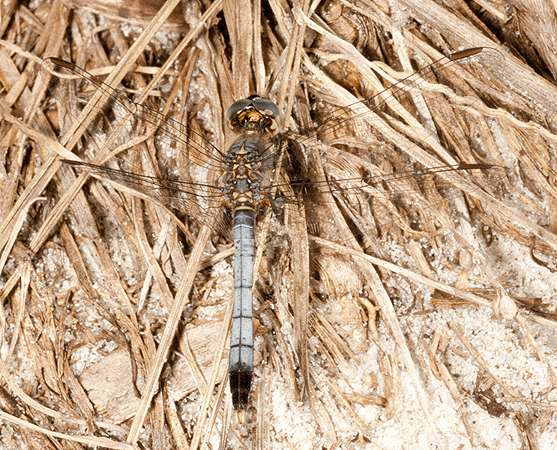
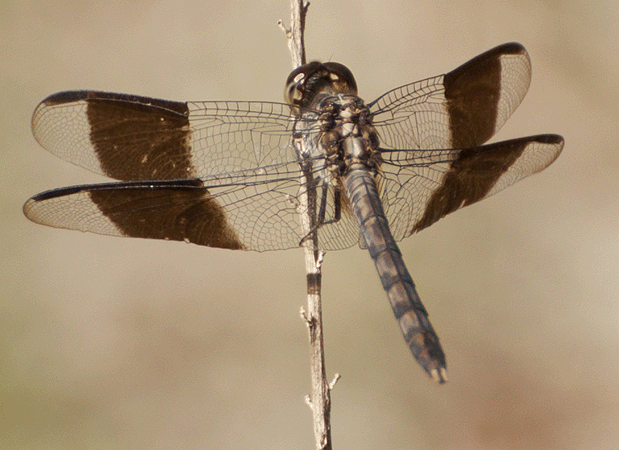 On February 11, 2015, this dragonfly was flitting from one dry
On February 11, 2015, this dragonfly was flitting from one dry 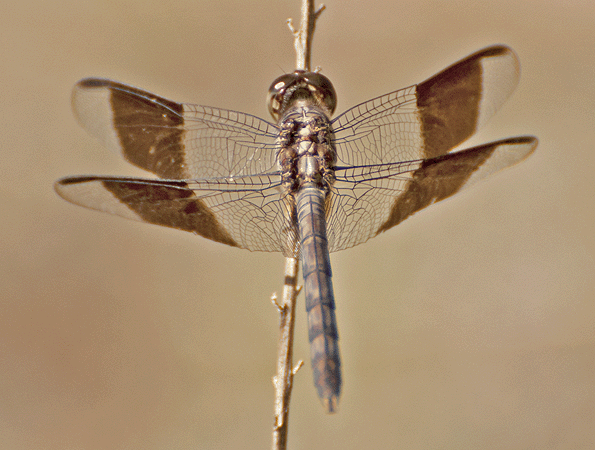 Erythrodiplax umbrata is a small to medium sized skimmer, known as a dragonlet. It has prominent bands on all four of its wings.
Erythrodiplax umbrata is a small to medium sized skimmer, known as a dragonlet. It has prominent bands on all four of its wings. 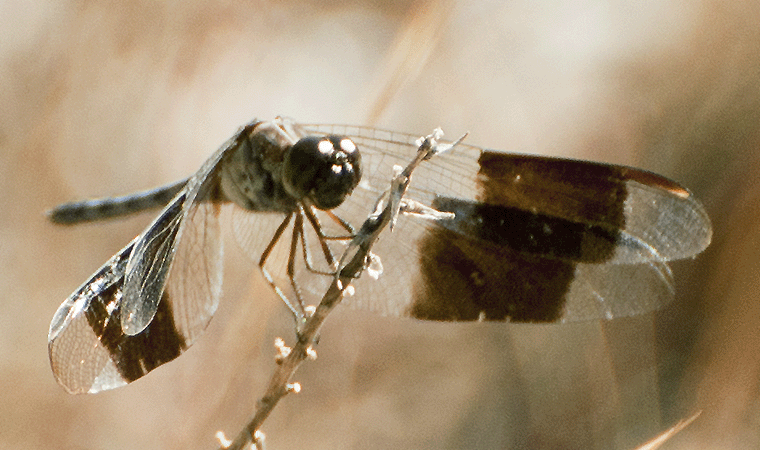
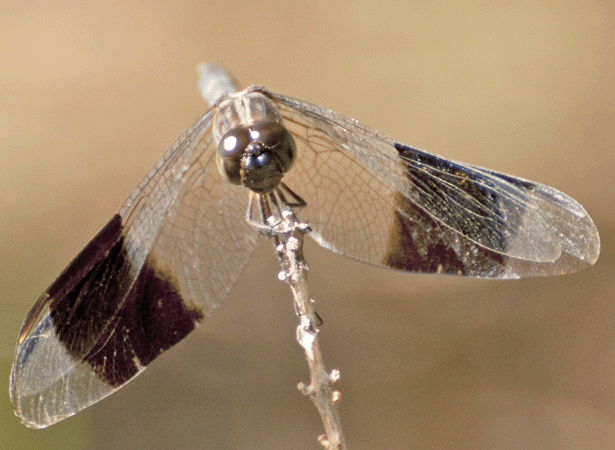
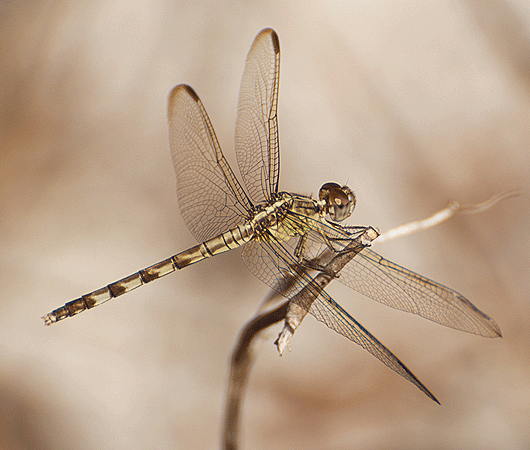 At left and below, this dragonfly was photographed on March 5, 2014. It was identified from the photographs on February 24, 2015 as a female Band-Winged Dragonlet by Jose Hernandez, a Contributor to <BugGuide.net>, sponsored by Iowa State University Department of Entomology because of its "brownish wingtips and longish abdomen."
At left and below, this dragonfly was photographed on March 5, 2014. It was identified from the photographs on February 24, 2015 as a female Band-Winged Dragonlet by Jose Hernandez, a Contributor to <BugGuide.net>, sponsored by Iowa State University Department of Entomology because of its "brownish wingtips and longish abdomen."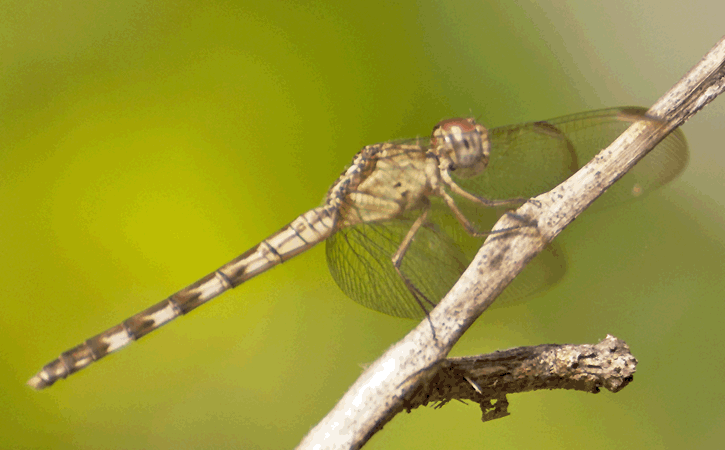
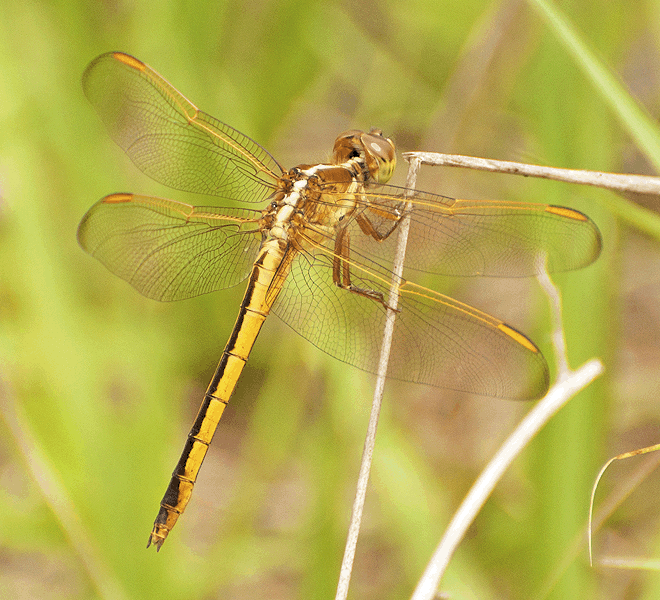 This first individual was photographed on April 23, 2013 in the Smith Preserve.
This first individual was photographed on April 23, 2013 in the Smith Preserve. 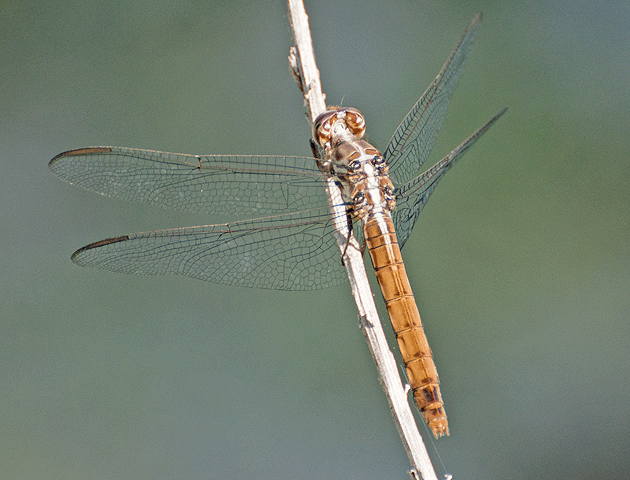
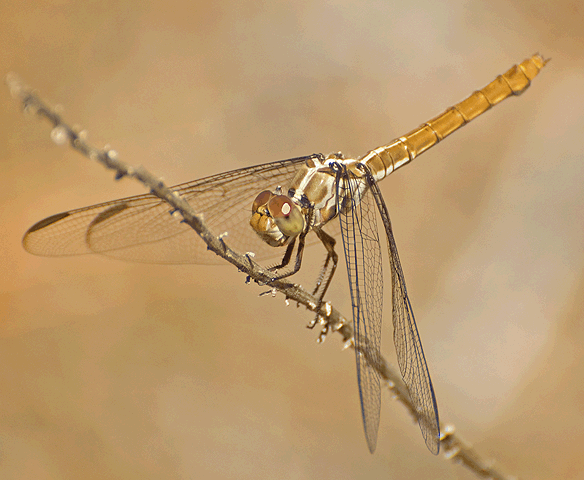
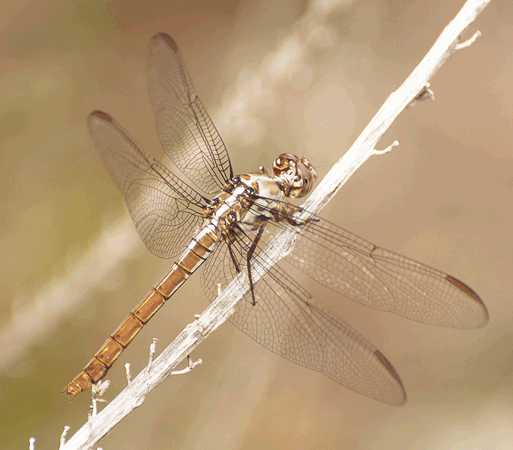
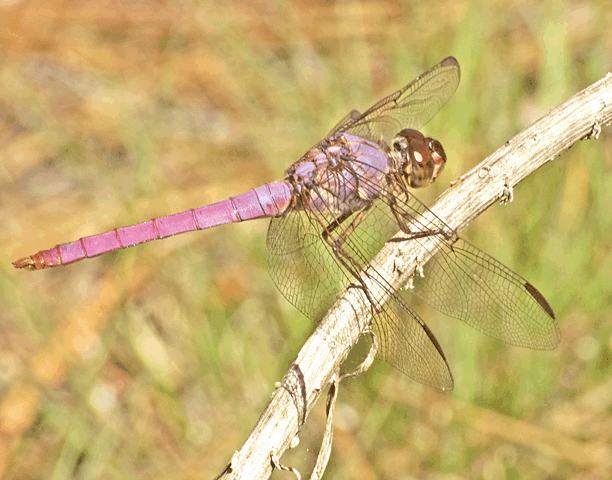
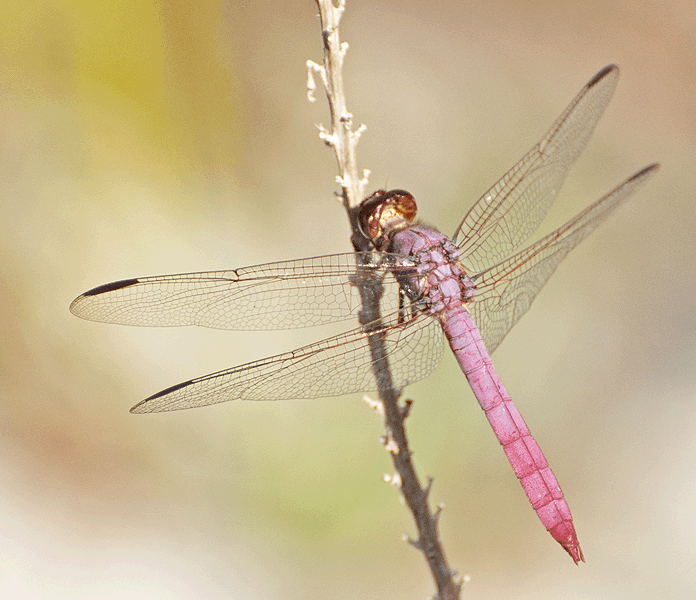
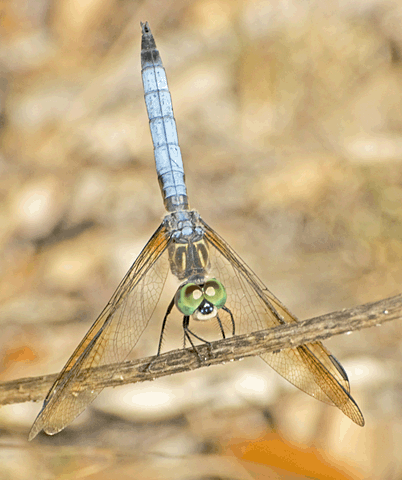
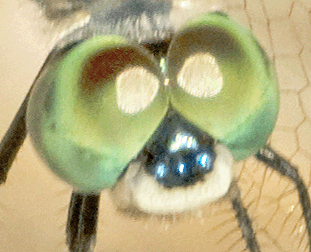
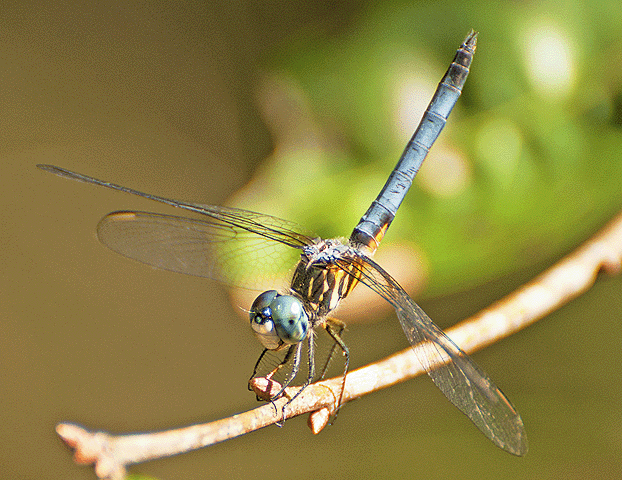


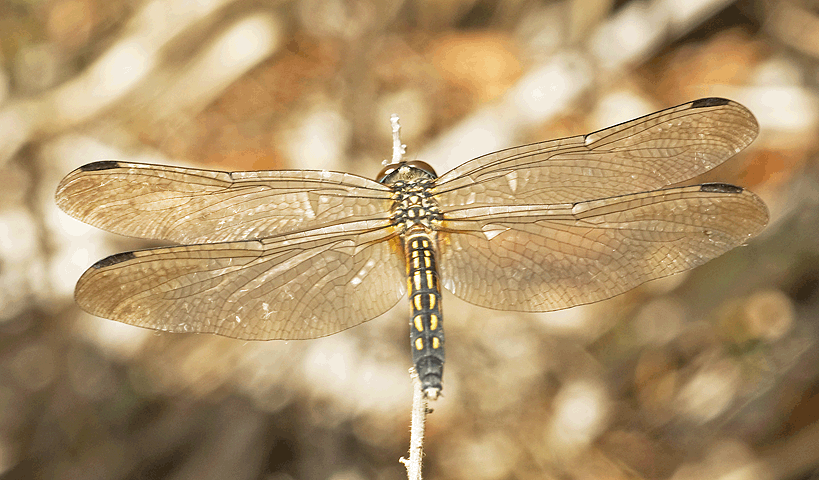
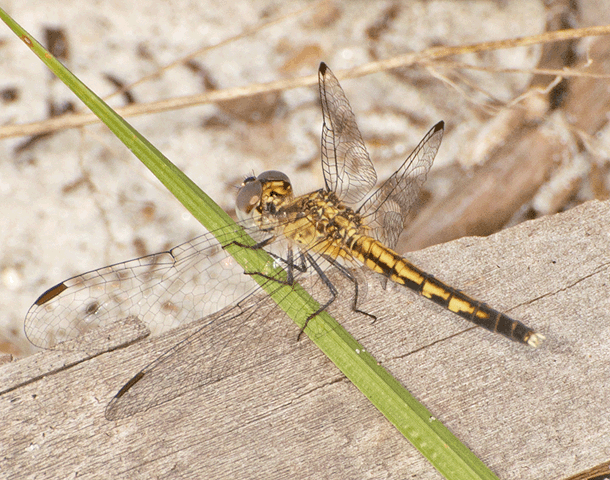 Blue Dasher Skimmers are widely distributed in the United States and can be found from southern Canada through Mexico. They are known to capture 300 insects/day.
Blue Dasher Skimmers are widely distributed in the United States and can be found from southern Canada through Mexico. They are known to capture 300 insects/day. 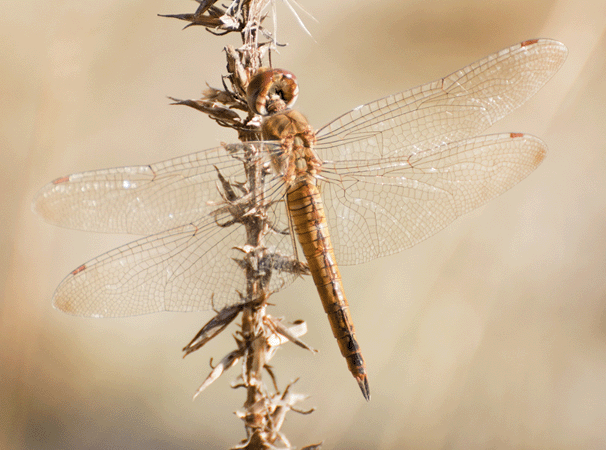
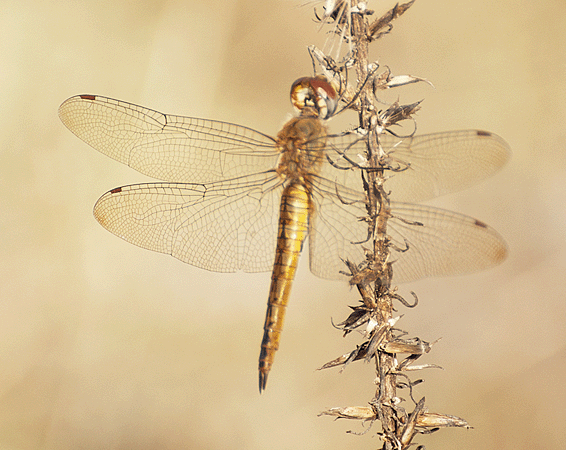 Pantala flavescens is found state-wide in Florida
Pantala flavescens is found state-wide in Florida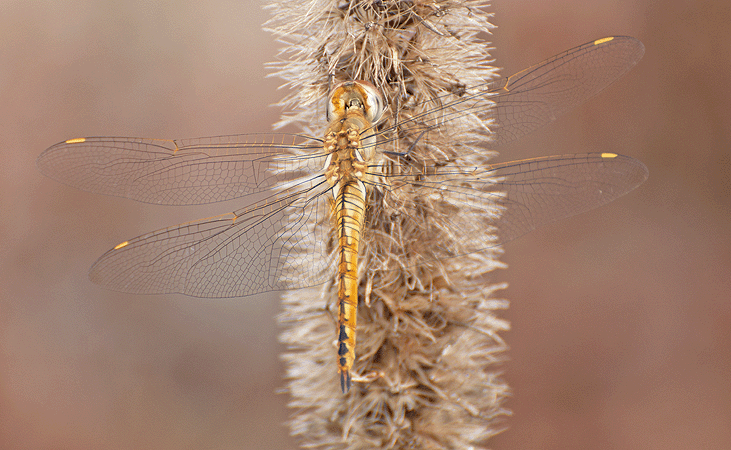
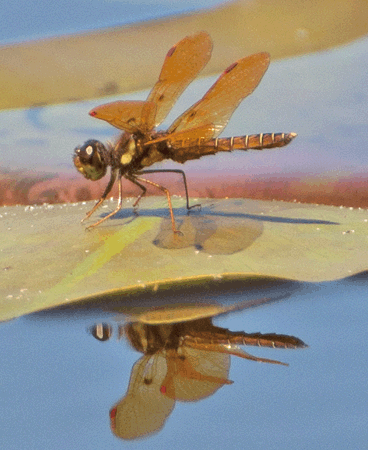 These tiny skimmers reach lengths of no more than 25 mm. The species name "tenera" means "delicate" and refers to its diminutive size.
These tiny skimmers reach lengths of no more than 25 mm. The species name "tenera" means "delicate" and refers to its diminutive size. 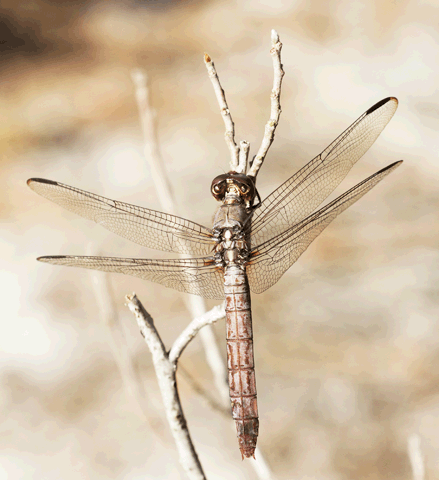
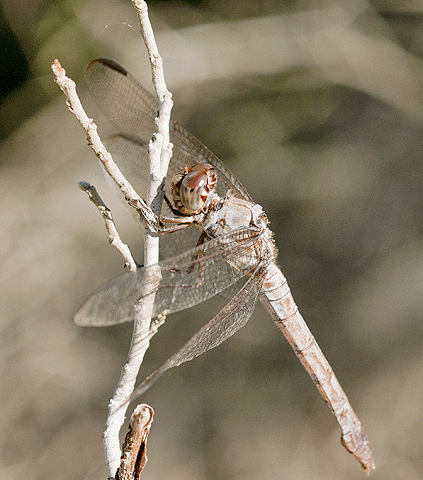
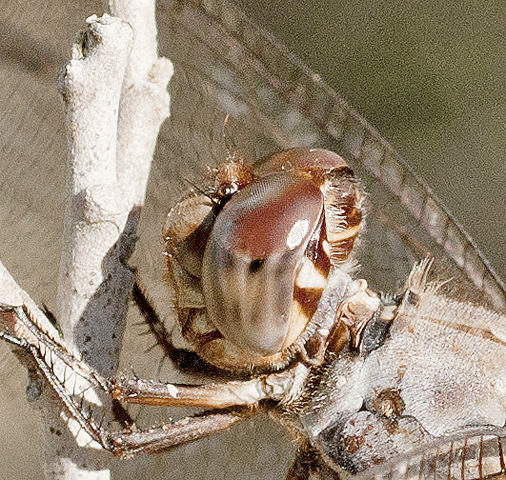
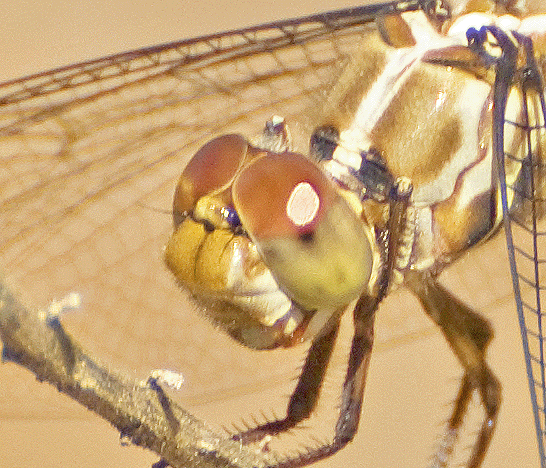
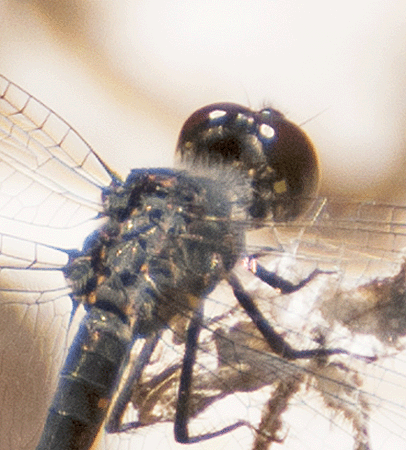 On July 10, 2015, it was confirmed as a member of Family Libellulidae by John S. Ascher, Contributing Editor of <BugGuide.net>, sponsored by Iowa State University Department of Entomology. The species has yet to be identified.
On July 10, 2015, it was confirmed as a member of Family Libellulidae by John S. Ascher, Contributing Editor of <BugGuide.net>, sponsored by Iowa State University Department of Entomology. The species has yet to be identified. 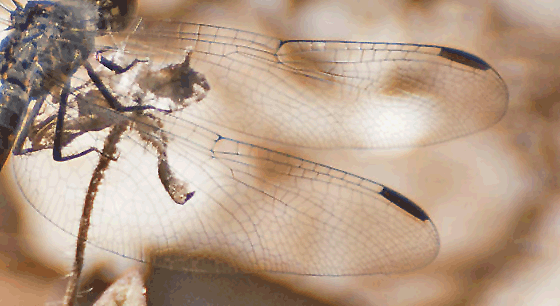
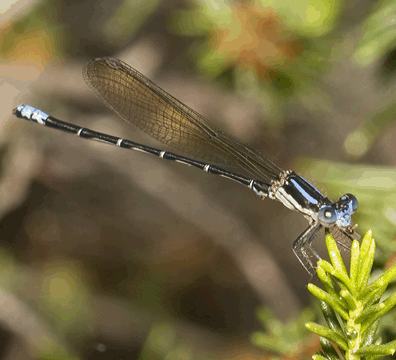
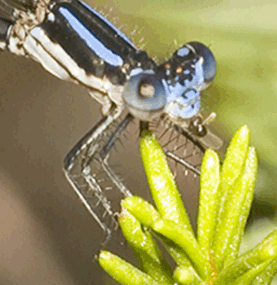 Dancer damselflies and bluets are sometimes confused for one another. As shown in the close-up at left, dancers have long setae on the front of their tibiae which are twice as long as the spaces between the setae. This is not the case with bluet damselflies. Also, dancers have a bouncy flight that distinguishes them from bluets. In fact, the species name "sedula" means "zealously."
Dancer damselflies and bluets are sometimes confused for one another. As shown in the close-up at left, dancers have long setae on the front of their tibiae which are twice as long as the spaces between the setae. This is not the case with bluet damselflies. Also, dancers have a bouncy flight that distinguishes them from bluets. In fact, the species name "sedula" means "zealously."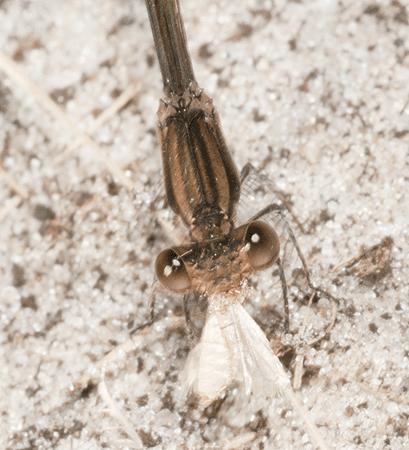
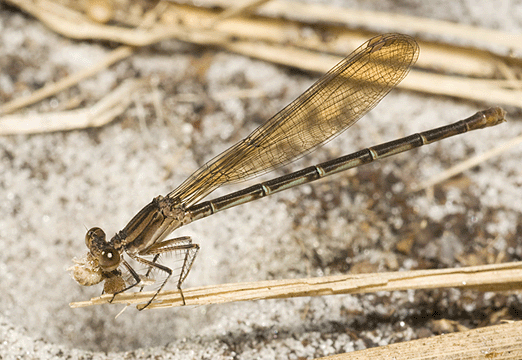
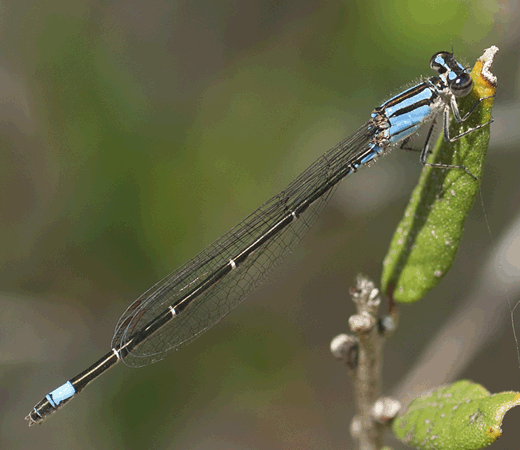 This photograph was taken in the Smith Preserve on April 23, 2012.
This photograph was taken in the Smith Preserve on April 23, 2012.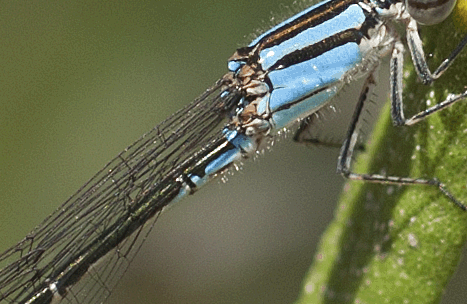
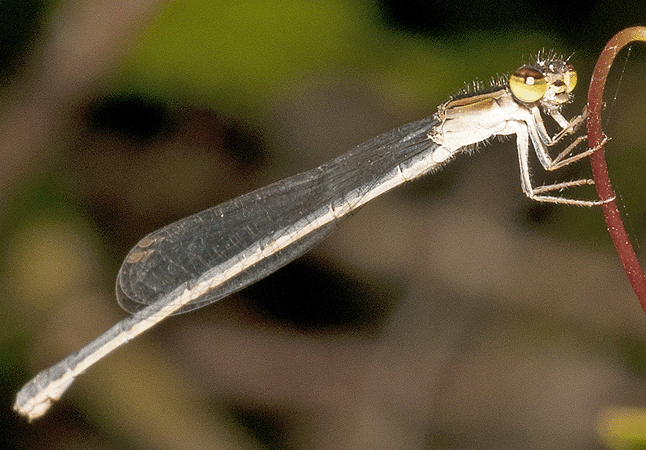 On March 11, 2015, this damselfly (images 1 and 2) was spotted resting on dried vegetation adjacent to the pond at the Smith Preserve. On March 27, 2015, it was identified from these photographs as a female Ischnura hastata by John and Jane Balaban, Contributing Editors to <BugGuide.net>, sponsored by Iowa State University Department of Entomology.
On March 11, 2015, this damselfly (images 1 and 2) was spotted resting on dried vegetation adjacent to the pond at the Smith Preserve. On March 27, 2015, it was identified from these photographs as a female Ischnura hastata by John and Jane Balaban, Contributing Editors to <BugGuide.net>, sponsored by Iowa State University Department of Entomology.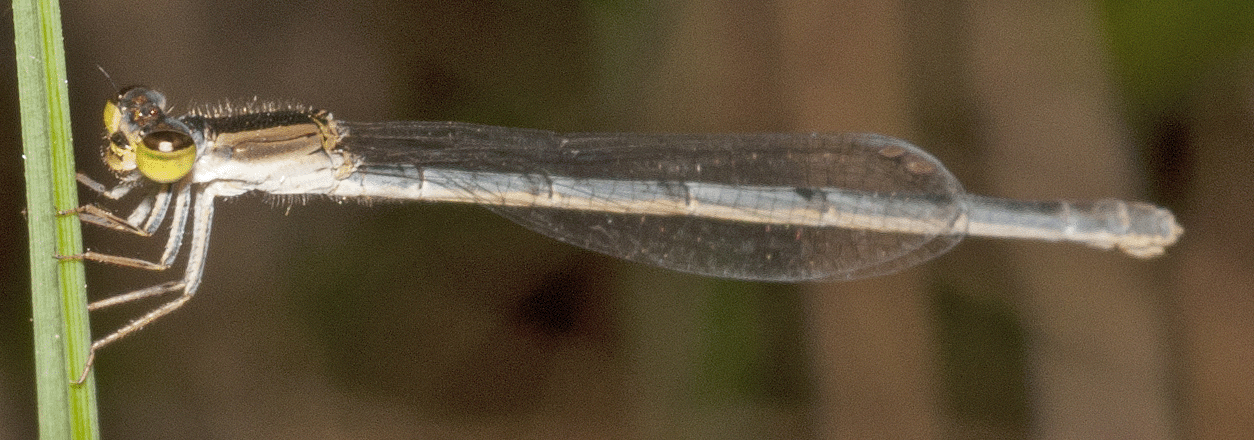


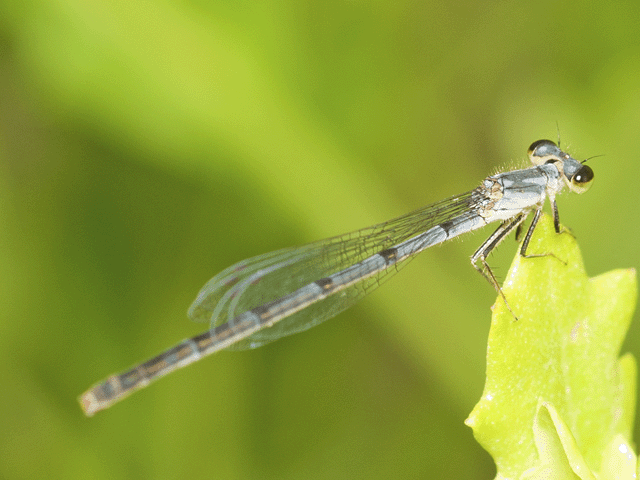
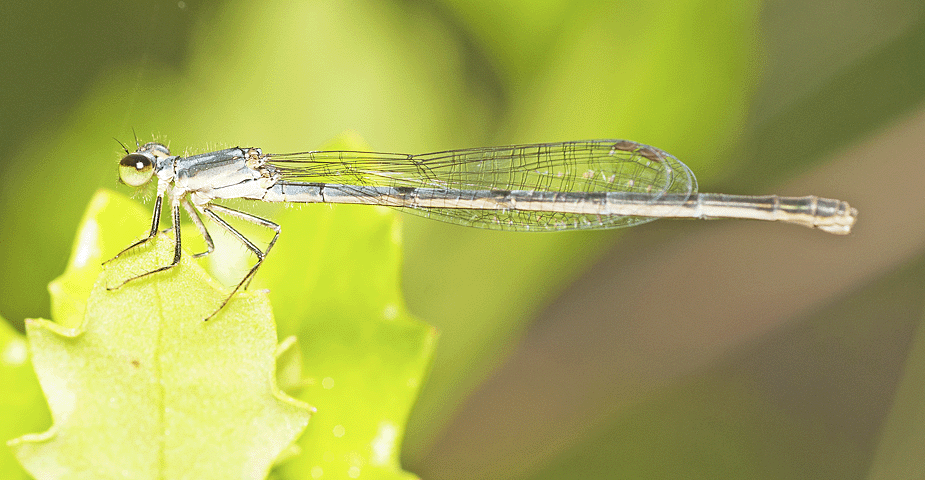 The Balabans explained that the clues to the identity of this damselfly as a mature female Ischnura posita is its powdery blue color, half green eyes, and a broken stripe on the shoulder.
The Balabans explained that the clues to the identity of this damselfly as a mature female Ischnura posita is its powdery blue color, half green eyes, and a broken stripe on the shoulder. 